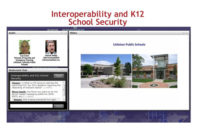To say that convergence has been a buzzword in the physical security industry for years may be an understatement. But the reality of convergence is here. There is the convergence of IT and physical security departments within an organization and the convergence of processes like enterprise risk management under the chief security officer’s purview.
Of course, most of the buzz has been dedicated to IP-enabled physical security products and although there is talk about technology convergence becoming a reality, today different manufacturers’ products will not work with one another without in-depth integration and custom software.
IP technology holds great promises for security practitioners such as scalability and flexibility, lower total cost of ownership, access to real-time information, and from a video perspective, higher resolution images and the ability to view video remotely from any network connection.
But the proprietary nature of IP systems has been a barrier to widespread adoption. Thankfully, efforts are underway to change this fact and move toward true convergence.
Currently, there are a number of technological standards in various stages of development. The Security Industry Association has been working on the Open Systems Interoperability and Performance Standard framework for a number of years. More recently, we have seen the emergence of the Physical Security Interoperability Alliance and the Open Network Video Interface Forum. ONVIF is focusing on developing standards for video surveillance while PSIA is working to promote the interoperability of IP-enabled security devices across all segments of the security industry including video, access control, analytics and software.
What PSIA, ONVIF and SIA are working towards will solve many of the issues security practitioners face with proprietary solutions. How will this specifically benefit you and your security program?
Lower Cost of Ownership
Interoperability will reduce integration costs as your integrator will not have to spend time consolidating disparate technologies. Systems can be expanded, modified and changed without the need for custom software development and in-depth integrations.
Systems will also be able to accept new and innovative technologies without the need for custom software applications and gateways, which often do not support each and every feature that a product might have on its own.
Finding ROI
The adoption of standards will also provide a higher return on investment as you will be able to leverage existing technologies, regardless of brand, as you build your security solution. As you add layered technologies over time, the overall system will continue to support legacy products, further supporting early investments.
Also, as future technology is developed, it can be immediately deployed in real-world applications rather than waiting for manufacturers to develop custom interfaces.
More Useful Information
Interoperable products will enable you to have access to more critical data. Systems are inherently more intelligent, as they share information seamlessly from system to system and offer a higher level of protection to your company and its assets. Access to more information will also enable you and your security department to operate in a proactive manner rather than purely being reactive. Additional access to critical data will also make your staff more efficient as they are able to anticipate potential breaches and respond in a planned, effective manner.
Best Solution Sets
Standards for IP-enabled devices will allow you to choose a best-in-class solution, regardless of brand. Without the limits of proprietary protocols, security practitioners will be able to build a multifaceted security solution to protect your organization, its employees, and assets.
We still have a long way to go, but there is a lot of excellent technology being developed. Standards groups continue to ramp-up their efforts. For example, manufacturers including IQinVision, Milestone, HikVision and Arecont Vision are moving forward with implementations of PSIA’s 1.0 Media Device specification, and end users are starting to demand these solutions.
Your input in this process is critical as these standards are being developed because these initiatives greatly affect how you will be able to use IP-based security products in the future. Associations like PSIA are working to support the industry by providing better solutions for the entire industry. We encourage you to be part of the process.
